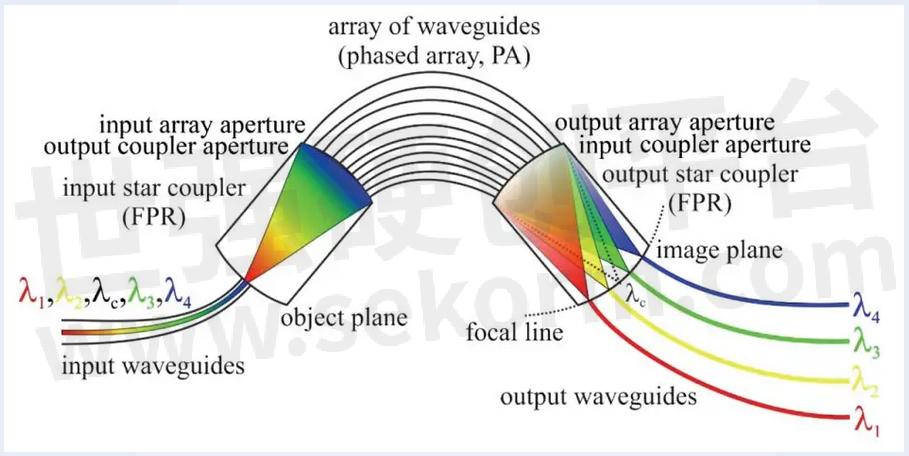What ‘s the AWG?

AWG, or Arrayed Waveguide Gratings are optical planar devices that
are normally used as multiplexers/ demultiplexers. Layouts of those
devices are primarily based on an array of waveguides with each imaging
and dispersive properties. Although AWGs also are recognized by
different names which include Phased Arrays (PHASARs), and Waveguide
Grating Routers (WRGs), AWG is the term we use the most in the telecommunications industry. Light waves of different wavelengths
intrude linearly with each other, for this reason, a couple of optical
channels with barely different wavelengths are able to be transmitted
over a single fiber with minimum crosstalk between adjacent channels,
and based on which, AWGs, therefore, can be used to multiplex a couple of
channels of different wavelengths on a single fiber on the transmitter
and additionally be used to demultiplex them back into their channels of different wavelengths on the receiver end.
Due to their function of multiplexing big numbers of wavelengths right into a single fiber, AWGs are generally used as optical multiplexers and demultiplexers in a WDM system. There are different applications which include sign processing, measurement, and sensing. Silica-on-Silicon and Indium Phosphide (InP) primarily based totally semiconductors are the mostly seen technology in the AWG market. The mode field suits nicely with that of an optical fiber, for this reason making them smooth to couple with losses of much less than 0.1dB. In addition, there may be additionally a totally low propagation lack of much less than 0.05dB/cm. InP is the dominant solution in the telecom field.
Working Principle and Features of the Device
An
AWG mainly consists of three parts, namely input/output optical fiber,
Free Propagation Region (FPR), and grating waveguide. Light waves of
different wavelengths enter the FPR through the input fiber. In FPR,
light waves are no longer confined to the fiber and become divergent and
enter the network of waveguides. The expanded light is then captured by
the grating waveguide transmitting it toward the aperture of the
output grating. The individual waveguides come in different lengths,
with the inner tubes being shorter than the outer ones. The difference
in the lengths of the adjacent waveguide is an integer multiple of the
central wavelength of the DeMUX. The wavelengths arrive at the other end
of the FPR at slightly offset times, with the signals from the inner
waveguide coming last and the outer waveguide arriving last. The lengths
of the array waveguides are chosen such that the optical path length
difference between adjacent waveguides is multiple of the center
wavelength of the demultiplexer. Therefore, the wavelengths from the
individual arrayed waveguides to the output coupler input aperture are
in different phases. Multiple beams of light structurally interfere and
converge to a single focal point at the output of the output coupler.

There are also AWGs designed with multiple inputs and an equal number of outputs. Such an AWG has a cyclic behavior that a signal entering input 1 will reappear at output 1 if the frequency is increased by an amount equal to the channel spacing. This device is called a cyclic wavelength router. This AWG type acts as an add-on multiplexer and wavelength switch.
Based on the configuration of the AWG and wavelength switching, additional multiplexers can be fabricated. The most basic add-on multiplexer can be made using two 1xN AWGs with identical wavelength responses. By combining demultiplexers with switches, additional configurable multiplexers can be fabricated. This configuration allows adding and subtracting wavelengths by means of an external control signal. The more multiplexers/demultiplexers added to the configuration increase the insertion loss of the multiplexer. Additional multiplexers with lower insertion loss can be realized by combining a single (N+1) x (N+1) AWG with a wavelength router in a loopback configuration. The demultiplexed wavelengths can be fed into switches where they can be routed to the bypass port or loop back to the wavelength router, which will then multiplex them to the output.
AWG Technologies
Many
technologies are used to develop AWG. The two main technologies used
are silica-on-silicon technology and indium phosphide semiconductor
technology.
Silica on Silicon (SoS) AWG
SoS
AWG was introduced to the market in the early 1990s and holds the
largest share of the AWG market. SoS is a type of planar lightwave
circuit (PLC) fabricated on a flat substrate by placing layers of glass
with high silicon content on a wafer. The composition of the glass
layers is very similar to that of an optical fiber, which facilitates
its coupling to the optical fiber due to its near-mode field
conformance. This results in low splicing and low propagation
attenuation. Another benefit of SoS AWG's PLC fabrication is its
excellent heat dissipation properties that make it suitable for
deployment in outdoor factory network environments.
Indium Phosphate-Based AWG (InP)
InP-based
AWG is a semiconductor-based AWG that can be integrated with multiple
active devices such as optical amplifiers and switches on a single chip.
The InP-based AWG can be fabricated in a compact package due to the
large index contrast of the InP-based waveguide. The optical
attenuation, coupling loss, and crosstalk performance of InP-based AWG
are not as good as that of silica-based AWG. Such a limitation is an
obstacle for InP-based AWG to be more widely used. The potential of
InP-based AWG to integrate into feature-rich circuits such as WDM
transceivers and optical add-on multiplexers is a big advantage. This
allows manufacturers to embed AWG functionality on active equipment to
create InP-based photonic integrated circuits (PICs) to reduce network
deployment costs. For example, add-drop multiplexing functions can be
performed at the transceiver without the need for an external
multiplexer. This reduces component and installation costs, as well as
the optical attenuation of many connectors.
Applications
From complex telecommunications connections to very simple add-on multiplexers, there are many applications where AWG can be used. In the telecom industry, AWG is mainly used as a multiplexer/demultiplexer in the WDM network. This is often deployed in long-distance networks such as international networks, national networks, and regional transport networks. The majority of PONs deployed worldwide use wavelength-independent optical splitters for power division and time division multiplexing for upstream and downstream transmission. This reduces deployment costs and eliminates the need for wavelength management for individual connections behind the splitter. With the growing demand for higher bandwidth, AWG is starting to be used in access networks allowing multi-wavelength transmission from the central office to the end user without significant modification to the existing fiber optic network. WDM-PON is a technology in which multiple WDM channels are transmitted over the same optical network from an optical line terminal (OLT) located in an exchanger.
- +1 Like
- Add to Favorites
Recommend
This document is provided by Sekorm Platform for VIP exclusive service. The copyright is owned by Sekorm. Without authorization, any medias, websites or individual are not allowed to reprint. When authorizing the reprint, the link of www.sekorm.com must be indicated.


























































































































































































































































































































































































































































































































































































































































































































































































































































































































